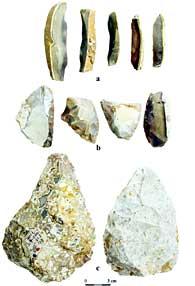Flint vessels found in a cave near the Crossing of Samaria road in the Kfar Qassem area testify to a rich culture that existed in the Middle East from 400 thousand years ago to 150 thousand years ago
Ran Shapira, Haaretz, voila!

Ashlo-Ibrodic flint tools from Merat Kesem. Top row: blades; Middle row: scrubbers; Bottom line: hand stones. Photo: Pavel Schargo
Direct link to this page: https://www.hayadan.org.il/kleyzor.html
At the foot of Kfar Qasem, near the lane that takes travelers west on the Trans-Shomron road, at the end of Gush Dan, there is a concrete wall separating the cars from the nearby hill. Above the wall stands a shed, covering the opening of a cave. Archaeological remains discovered in this cave in the last three years can provide a key to understanding human development in the Middle East hundreds of thousands of years ago.
The site was discovered in the summer of 2000, as a result of an explosion carried out by NRA workers who were involved in widening the road. Prof. Amos Fromkin, a geologist from the Hebrew University of Jerusalem who conducts research in the area, found prehistoric remains in the rubble that covered the cave following the explosion - flint tools and animal bones - and worked to stop the work.
In the excavations carried out at the site by Prof. Avi Gofar and Dr. Ran Barkai from the Institute of Archeology at Tel Aviv University, a series of layers was found at a depth of about seven and a half meters. The findings have been waiting since the cave was abandoned, more than 150 thousand years ago, and have been well preserved. Most of them are associated with a prehistoric culture with distinct characteristics - the Ashlo-Hybrodic culture.
This culture appeared in the south of the Middle East immediately after the Illusory culture, which was created by a man of the homo-erectus type and existed between 1.5 million and 400 thousand years before our time.
After the disappearance of the Ashlo-Hebridean culture flourished the Mousterian culture (65-200 thousand years before our time), which in the Middle East is associated with two different species of hominids, the early modern man and the Neanderthal man. The researchers assume that the cave served as a center of settlement for the members of the Ashlo-Yibrodic culture, who frequented it repeatedly for more than 200 thousand years.
One of the questions that Gopher, Barkai and their research partners at Merat Kesem hope to answer is who was responsible for the changes that characterized the Ashlo-Hybrid culture - modern man or Homo erectus. In the Middle East only a few sites attributed to this culture have been found - in Syria, Lebanon and also in Israel - but in none of them have findings been excavated that can provide an answer to this intriguing question, related to the ancestor of the modern man alive today.
One of the most prominent characteristics of the Ashlo-Yibroid culture, says Dr. Barkai, is relatively rapid technological changes. A large and impressive flint tool, known as a hand stone, is very prominent in the Ishlite culture. Tools of this type were produced by Homo erectus for more than a million years and were used by him for a variety of activities, such as hunting and cutting meat and plants. The handstones are carefully crafted tools that teach about the skill and abilities of the homo-erectus.
The Ashlo-Hybrid culture began to develop in our region about 400 thousand years ago. At that time the hand stones began to disappear. Next to the remaining hand stones, two special types of tools appeared: thick scrubbers, which were used mainly for processing hides and plant material, and blades, which were used mainly for butchering animals and cutting meat. The blades found in the Ashlo-Hebridean sites attracted special attention, because until the discovery of this culture, the production of blades was considered a unique and sophisticated craft, characteristic only of modern humans.
About 200 years ago, the Ashlo-Hybrid culture was replaced by the Mousterian culture, which brought with it a significant technological change. The production of the handstones was completely stopped and so was the systematic production of blades. The members of the Mousterian culture produced their flint tools using a completely different method, also complex and sophisticated, known by the researchers as the Labois technique; This technique is characterized by careful planning of the design of the block of raw material. The significant technological innovations of the Ashlo-Yibrodic culture left no trace in the transition to the Mousterian culture.
Since the hand stones are identified above all with Homo erectus and the Labois technique is identified with Neanderthal and modern humans, the question arises whether the unique flint tools of the Ashlo-Hybrid culture indicate the presence of a unique human type in the Middle East. Magic Cave researchers hope to answer this intriguing question in an excavation project that will last for many years and will try to find the connection point between human evolution and the system of technological and economic changes.
Remains of animal bones are found in all layers of the cave and testify to the hunting of large animals, mainly donkeys and wild cattle. The animals were hunted near the cave, but only selected body parts, such as fore and hind limbs, were brought to the cave itself. This indicates considerations of expediency taken by the inhabitants of the cave at a very early stage in human history.
The excellent state of preservation of the findings in Merat Kesem will allow for in-depth research on various aspects of human development. The researchers will be able to learn about the production methods of flint tools, the diet of the cave dwellers, their relationships with neighbors and more. They hope that the cave, located in the bridging area between Africa and Europe and Asia, will help draw conclusions about the development of humanity and the spread of humans from Africa to the rest of the world.
